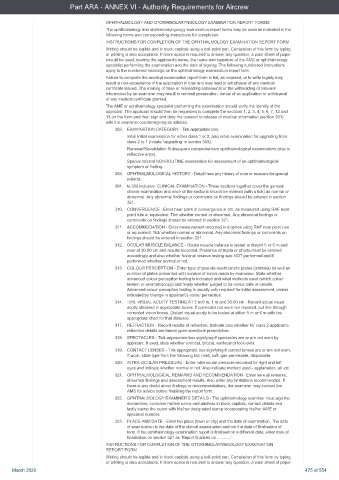Page 475 - UK AirCrew Regulations (Consolidated) March 2022
P. 475
Part ARA - ANNEX VI - Authority Requirements for Aircrew
OPHTHALMOLOGY AND OTORHINOLARYNGOLOGY EXAMINATION REPORT FORMS
The ophthalmology and otorhinolaryngology examination report forms may be used as indicated in the
following forms and corresponding instructions for completion.
INSTRUCTIONS FOR COMPLETION OF THE OPHTHALMOLOGY EXAMINATION REPORT FORM
Writing should be legible and in block capitals using a ball-point pen. Completion of this form by typing
or printing is also acceptable. If more space is required to answer any question, a plain sheet of paper
should be used, bearing the applicant’s name, the name and signature of the AME or ophthalmology
specialist performing the examination and the date of signing. The following numbered instructions
apply to the numbered headings on the ophthalmology examination report form.
Failure to complete the medical examination report form in full, as required, or to write legibly may
result in non-acceptance of the application in total and may lead to withdrawal of any medical
certificate issued. The making of false or misleading statements or the withholding of relevant
information by an examiner may result in criminal prosecution, denial of an application or withdrawal
of any medical certificate granted.
The AME or ophthalmology specialist performing the examination should verify the identity of the
applicant. The applicant should then be requested to complete the sections 1, 2, 3, 4, 5, 6, 7, 12 and
13 on the form and then sign and date the consent to release of medical information (section 301)
with the examiner countersigning as witness.
302. EXAMINATION CATEGORY - Tick appropriate box.
Initial Initial examination for either class 1 or 2; also initial examination for upgrading from
class 2 to 1 (notate ‘upgrading’ in section 303).
Renewal/Revalidation Subsequent comprehensive ophthalmological examinations (due to
refractive error).
Special referral NONROUTINE examination for assessment of an ophthalmological
symptom or finding.
303. OPHTHALMOLOGICAL HISTORY - Detail here any history of note or reasons for special
referral.
304. to 309 inclusive: CLINICAL EXAMINATION - These sections together cover the general
clinical examination and each of the sections should be marked (with a tick) as normal or
abnormal. Any abnormal findings or comments on findings should be entered in section
321.
310. CONVERGENCE - Enter near point of convergence in cm, as measured using RAF near
point rule or equivalent. Tick whether normal or abnormal. Any abnormal findings or
comments on findings should be entered in section 321.
311. ACCOMMODATION - Enter measurement recorded in dioptres using RAF near point rule
or equivalent. Tick whether normal or abnormal. Any abnormal findings or comments on
findings should be entered in section 321.
312. OCULAR MUSCLE BALANCE - Ocular muscle balance is tested at distant 5 or 6 m and
near at 30-50 cm and results recorded. Presence of tropia or phoria must be entered
accordingly and also whether fusional reserve testing was NOT performed and if
performed whether normal or not.
313. COLOUR PERCEPTION - Enter type of pseudo-isochromatic plates (ishihara) as well as
number of plates presented with number of errors made by examinee. State whether
advanced colour perception testing is indicated and what methods used (which colour
lantern or anomaloscopy) and finally whether judged to be colour safe or unsafe.
Advanced colour perception testing is usually only required for initial assessment, unless
indicated by change in applicant’s colour perception.
314. -316. VISUAL ACUITY TESTING AT 5 m/6 m, 1 m and 30-50 cm - Record actual visual
acuity obtained in appropriate boxes. If correction not worn nor required, put line through
corrected vision boxes. Distant visual acuity to be tested at either 5 m or 6 m with the
appropriate chart for that distance.
317. REFRACTION - Record results of refraction. Indicate also whether for class 2 applicants,
refraction details are based upon spectacle prescription.
318. SPECTACLES - Tick appropriate box signifying if spectacles are or are not worn by
applicant. If used, state whether unifocal, bifocal, varifocal or look-over.
319. CONTACT LENSES - Tick appropriate box signifying if contact lenses are or are not worn.
If worn, state type from the following list; hard, soft, gas-permeable, disposable.
320. INTRA-OCULAR PRESSURE - Enter intra-ocular pressure recorded for right and left
eyes and indicate whether normal or not. Also indicate method used - applanation, air etc.
321. OPHTHALMOLOGICAL REMARKS AND RECOMMENDATION - Enter here all remarks,
abnormal findings and assessment results. Also enter any limitations recommended. If
there is any doubt about findings or recommendations, the examiner may contact the
AMS for advice before finalising the report form.
322. OPHTHALMOLOGY EXAMINER’S DETAILS - The ophthalmology examiner must sign the
declaration, complete his/her name and address in block capitals, contact details and
lastly stamp the report with his/her designated stamp incorporating his/her AME or
specialist number.
323. PLACE AND DATE - Enter the place (town or city) and the date of examination. The date
of examination is the date of the clinical examination and not the date of finalisation of
form. If the ophthalmology examination report is finalised on a different date, enter date of
finalisation on section 321 as ‘Report finalised on ............’.
INSTRUCTIONS FOR COMPLETION OF THE OTORHINOLARYNGOLOGY EXAMINATION
REPORT FORM
Writing should be legible and in block capitals using a ball-point pen. Completion of this form by typing
or printing is also acceptable. If more space is required to answer any question, a plain sheet of paper
March 2022 475 of 554

